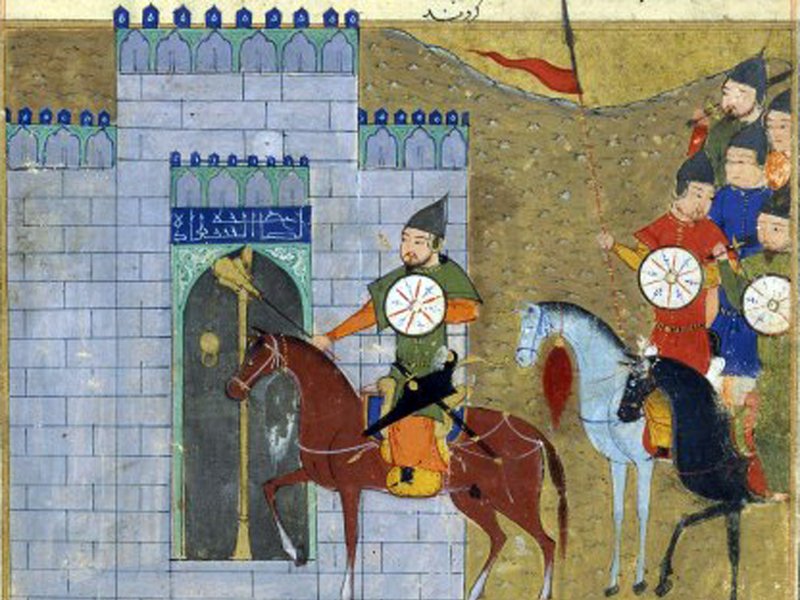Mongolia, with the lowest population density of any country in the world—about 2 people per square kilometer—would appear an unlikely birthplace for the largest contiguous empire in the history of the world. Today’s inhabitants (which number fewer than three million in a country the size of California, Texas, Montana and West Virginia combined) are largely dependent on livestock production for their livelihoods. Much of the population practices a form of nomadic pastoralism in which herders follow their animals.
But in the early 1200s, Genghis Khan united the Mongol tribes and began invading neighbors in all directions. The Mongol Empire continued to grow after his death, led by the mighty leader’s sons and grandsons, who pushed their armies into regions as far as eastern Europe, the Middle East, Southeast Asia and Korea.
This great empire was made possible not by brilliant leadership alone, but by a 15-year period of abnormal moisture and warmth in central Mongolia in the early 1200s, according to Neil Pederson of Columbia University’s Lamont-Doherty Earth Observatory and colleagues, who report their findings in the Proceedings of the National Academy of Sciences. A brief change in the local climate, they say, was key in the rise of the Mongols.
The research team was able to reconstruct the climate of central Mongolia from tree rings—relying on how the width of the concentric circles changes annually and reflects the yearly trend in temperature and moisture. Two of the researchers had discovered a stand of ancient Siberian pines growing out of the cracks in an old lava field in the Khangai Mountains of Central Mongolia. They took cross-sections of dead trees and cores of living ones. They calibrated the width of the rings with instrumental climate data collected from 1959 to 2009 and created a key that let them determine weather going back 1,112 years.
The tree rings reflected several global-scale climate events, such as the Little Ice Age and the beginning of the Anthropocene. But the researchers could also see important local climatic changes.
From 1180 to 1190, Central Mongolia experienced an intense drought that probably contributed to the political instability of that time. Established patterns of leadership were disrupted, and the region saw continuous warfare. “The worsening dry conditions…would have been an important contributing factor in the collapse of the established order and emergence of a centralized leadership under [Genghis] Khan,” the researchers write.
In 1211, Central Mongolia then entered its most unusual period in the millennium-long record: a 15-year stretch that was warm and, more importantly, incredibly wet. Those conditions would have provided a surplus of grass for both the horses for the Mongol army—each trooper would bring three to five horses so that he always had a fresh ride—and the livestock that followed the army to keep the warriors fed.
Without an increase in productivity, the pastoralism practiced in this region of the world would not have provided enough surplus resources for such efforts. All the resources available would have had to be devoted to keeping people alive, as they largely are now. Genghis Khan may have been a great leader, but without the warm, wet years to give the region a boost, he wouldn't have had the resources for building a strong government and large army. The world may have been a very different place.
The Mongol Empire split into four smaller empires in 1260, and each of these continued to expand into the 14th century, eventually failing due to internal disputes. The legacy of the great empire, however, lives on, perhaps most notably in human DNA: Sixteen million men across the former Mongol Empire share an identical Y chromosome, the likely legacy of a former pillager, perhaps the Great Khan himself.
The current occupants of Mongolia, though, are now dealing with a period of much harsher climate than what was experienced in the early 1200s. The region suffered a drought from 2002 to 2009, which, the tree rings reveal, was as bad in length and lack of precipitation as what was seen in the 1180s and hotter than anything in the 1,112-year record.
A new invasion has taken place, but one far different than what Genghis Khan led: People from rural areas are flooding into Mongolia's capital, Ulaanbaatar. Unusually cold and long winter of 2009 to 2010 killed at least 8 million animals, about 17 percent of the nation’s herd. Many herders lost their livelihoods and nearly half a million migrated to Ulaanbaatar in search of jobs. Weather, it seems, can make invaders of us in one way or another.
